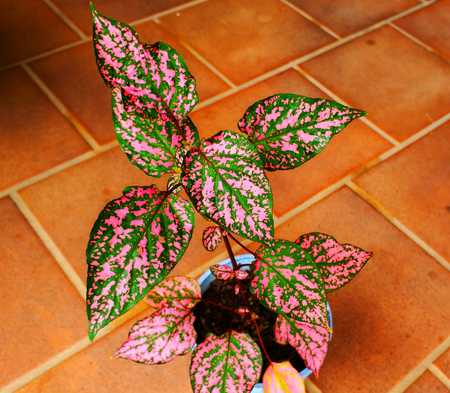The article gives details on growing and caring for polka dot plant indoors in bathroom or outdoors and how to fix a leggy plant.
Polka dot plants (Botanical name: Hypoestes phyllostachya, formerly Hypoestes sanguinolenta) are native to southern Africa, Madagascar and parts of southeast Asia, so they thrive in warm and humid environments.
 |
| Polka Dot Plant Hypoestes phyllostachya |
Another names for polka dot plant are pink polka dot plant, measles plant, freckle face plant, splash plant, etc. They look very eye-catching and can be grown indoors and outdoors in garden beds and containers. The plant has brightly spotted or variegated leaves which look like polka dots, so the name polka dot plant.
Most polka dot plants have green leaves with pink spots, but they also come in purple, white, or red variegation.
Polka dot plant grow to a height of 6 to 18 inches with a moderate growth rate, but the growth will slow down in unfavorable conditions. The polka dot plant is a perennial plant, but you can grow it as an annual plant in USDA zones 10-11.
Polka Dot Plant Care
Soil
The polka dot plants like well-draining rich potting soil with some organic amendments like compost, peat moss and river sand or perlite. The plant does not tolerate soil containing salt.
Light: Where to Grow Polka Dot Plant
Polka dot plant grows best in bright and high humid warm location.
The plant can stop growing if it is in too dark for long time. But in any case, avoid direct sunlight. Direct sunlight can cause the color to fade and scorch the leaves or even burn up the foliage.
Growing Indoors
Your polka dot plant will produce the best leaf color if you place it in bright light with a minimum temperature of around 21ºC (70°F) and a humidity around 60%. You can mist the leaves to maintain the humidity level or place the pot on pebbles in a tray filled with water.
Indoors, place your plants in bright, filtered sunlight of an east- or west-facing window. Polka dot plants like the bathroom. A warm bathroom or terrarium is ideal location if it has sufficient light. Too little light can also cause leaves to lose their colour resulting in a less colorful plant.
Growing Outdoors
The plant need the same environmental conditions outdoors, grow them in partial sun to full shade.
Keep your polka dot plant outdoor if daytime temperature remains at least 15ºC (60ºF) and nighttime temperatures remains above 10ºC (50ºF).
Watering
Water the plant when the top half inch of soil dries up. Water the plant to equally saturate the soil.
The soil should be consistently wet but not soggy. The water should freely drain from the pot to avoid waterlogging, so it is very important to use a free-draining soil in a pot having several drainage holes. Do not use any saucer beneath the pot to collect excess water, an if you use it, then empty it after watering.
Reduce watering in winter, and increase again in spring.
Fertilizer for Polka Dot Plant
Polka dot plants need regular feeding. If growing in a pot, fertize your polka dot plant every 2 weeks during the growing season with a liquid fertilizer like Powerfeed or Miracle Grow, but every other month during rest of the year.
In growing in ground, feed a slow-release all-purpose plant fertilizer. Feed once a month with a general purpose, liquid fertilizer.
Diseases and Pests
Plants have few pest problems, but may become infested with whiteflies, aphids, mealybugs and spider mites. Insects problem can be handled by a spray of neem oil.
The plants are susceptible to powdery mildew and root rot when watered on foliage or overwatered.
Keep the soil evenly moist to prevent wilting and leaf drop.
Polka Dot Plant Problems
Your plant may have some problems. The leaves of the plant are the best indicators of its health.
- Foliage fading: Move the plant to a brighter location, but away from direct sunlight.
- Scorched foliage: Too much sun exposure, move the pot to shade.
- Curled up Foliage: Too much sun exposure, move the pot to shade.
- Leaves droop or turning brown: Plant is thirsty or lack of humidity, water frequently and mist the leaves or move the plant to a more humid environment.
- Leaves turning yellow: Sign of overwatering. Stop watering and check the roots for any rot. repot the plant, if necessary.
- Polka dot plant flowering: Either the roots dry out or reduced lighting when days get shorter in autumn and winter. Remove the flowers to keep the plant looking good. To keep your polka dot plant alive after flowering, reduce water and resume watering only after the new growth emerges.
- Plant becoming leggy: No pruning and /or low light level. How to fix a leggy polka dot plant? Read below:
 |
| Leggy Polka Dot Plant |
Pruning
Regular pruning maintains the desired shape and size of the plant. Without regular pruning or in lower light level, the plant will get leggy.
Pinch back the growing tips of the stems regularly throughout the growing season.
How to Fix a Legging Polka Plant
 |
| Pruning a Leggy Polka Dot Plant to make it bushy |
Polka Dot Plant Propagation
Polka dot plants can be grown from seeds and stem cuttings. Propagate polka dot plant in spring to summer.